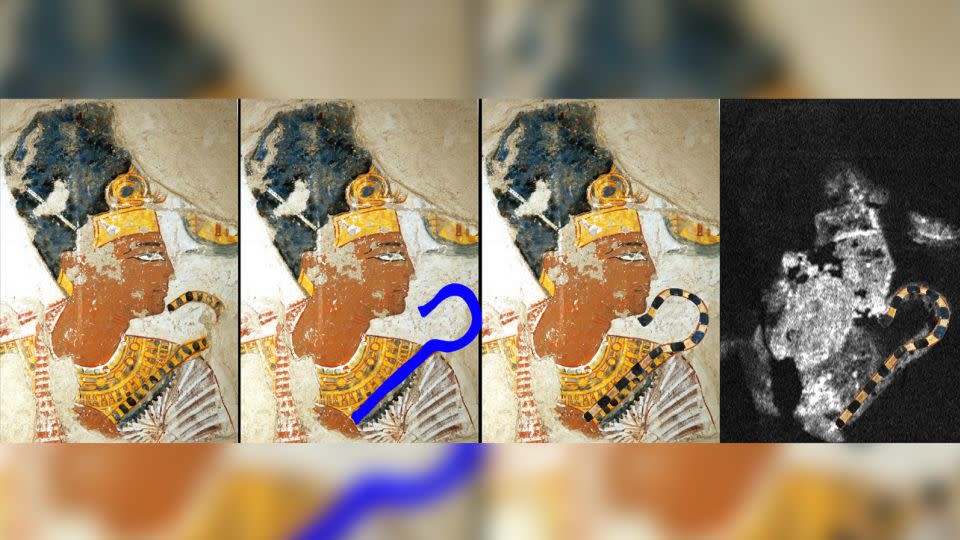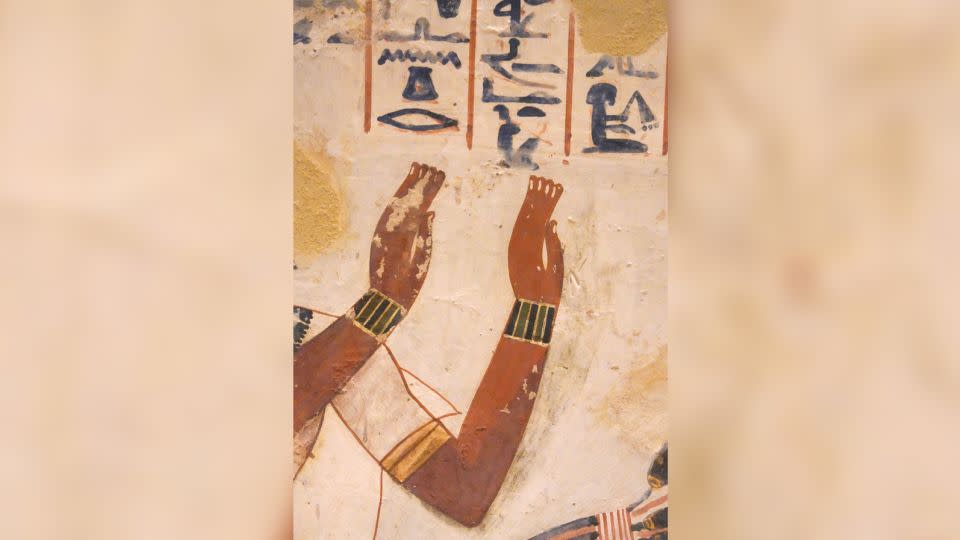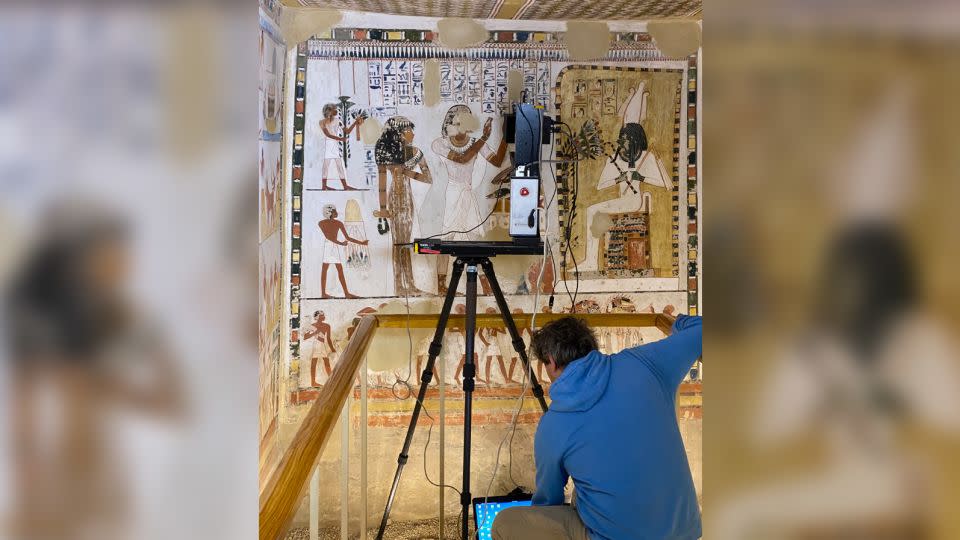Chemical imaging reveals hidden details in Egyptian paintings
Editor’s Note: Sign up for CNN’s Wonder Theory science newsletter. Explore the universe with news on fascinating discoveries, scientific advancements and more.
Researchers using a cutting-edge technique have discovered hidden details in two ancient Egyptian paintings in the Theban Necropolis, near the River Nile, that date back more than 3,000 years.
The paintings are located within the tombs, in chapels where people could gather to commemorate the dead.
Using portable chemical imaging technology, the researchers identified alterations made by the artists that are rare in Egyptian paintings, commonly thought to be the product of highly formalized workflows.
The study is also trying to upend tradition in Egyptology, as the analysis was performed in the tombs with advanced portable devices, whereas most studies are traditionally performed in museums or laboratories.
“What is new is the way we are trying to use those tools,” said Philippe Martinez, an Egyptologist at the Sorbonne University in Paris and lead author of the study published Wednesday in the journal PLOS ONE.
“The way these works of art have been dealt with before has been mainly, purely analog, and they have been somewhat taken for granted — nobody has been really looking at them from the point of view of the artists. We want to understand how these paintings were made.”

Chemical imaging technology involves X-ray fluorescence. X-rays, which are more commonly used in checking for fractures, create a map of the surface of the painting down to the molecular level, including its chemical properties. Another process, hyperspectral imaging, analyzes the painting on multiple wavelengths, such as ultraviolet or infrared, revealing more than is visible to the human eye.
The digital technology was used in two tombs that both date from the Ramesside Period (1292 BC to 1075 BC) in ancient Egypt.
Disappearing hands
The first painting in the study is in the tomb chapels of Menna, an official who served under pharaoh Amenhotep III. The work is considered “the apogee of ancient Egyptian painting,” the study noted, and the alteration that was observed is currently visible to the naked eye — possibly as a result of chemical alteration through time — but it was hidden when the painting was new.
“Menna is a little bit like the Mona Lisa of Egypt,” Martinez said. “It’s one of the best tombs, known for 200 years, very well preserved.”
In one scene, Menna and his wife are adoring Osiris, one of ancient Egypt’s most important gods, and Menna raises his hands in front of his face. A third hand, however, is hidden under the white background layer, making it clear that the figure had been retouched.
“We already knew it was there. We have a very clear view of the secondary arm that was changed afterwards. But we cannot say when it was changed, or even why it was changed,” Martinez said.
“The interesting thing is that even if it was just seen as a mistake to be corrected, the way it is corrected differs very, very strongly from the original. Either the owner of the tomb, or the group of artists, or whoever was directing the process, saw this as something that was wrong, but it was corrected with materials and artistic means that show a completely different thought process.”
This small detail could suggest new clues about the painting process. While tomb decorations are generally believed to be the work of several people working in parallel, these modifications open the possibility that the paintings were instead done by different groups over different sessions, the study noted.

The other painting is in the tomb of Nakhtamun, a cleric. Unlike those in the tomb of Menna, these works are underrated and “simply inaccessible,” according to the study. The analysis of the painting of a pharaoh, Ramesses II, uncovered various alterations to his crown, necklace and other royal items, most likely due to some change in symbolic meaning over time.
“This representation of Ramesses II, interestingly, shows him with a budding beard,” Martinez said.
“And that’s very weird because we almost have no images of pharaohs with a stubble — they usually look dreamlike, like superheroes, shown in stances that are sort of eternal in some ways. But showing someone with a beard means showing someone in a moment of his life, and that is very rare.”
Some of the details that chemical imaging has uncovered are especially puzzling, Martinez added. “Chemical imaging was giving us not only different colors, but also different shapes for the neck of the king; the Adam’s apple is never shown in Egyptian art, but here we have one clearly visible. The corrections also show an image that was not perfect.
“Egyptians liked perfection and beauty, but this is not that, because the shape of the scepter is slightly weird: It touches the face of the king. This shows how the artist was actually working and how corrections can lead to something that is less perfect than before. It must have meaning, but that still escapes us,” he said.
Upending tradition
By highlighting these hidden details through an analysis done on-site, Martinez and his colleagues want to challenge traditionally established assumptions about Egyptian art.
“As an Egyptologist I’m trying to forget what I know, because the accumulated knowledge of the last 200 years is stopping us from seeing what is in front of us,” he said.
“We have to relearn the Egyptian paintings and look at them in a new way, because the colors are now very different from what they used to be — hopefully the chemical analysis will help us to actually redefine them.”
He adds that digital tools also speed up a process that would otherwise be excessively slow.
“Studying a tomb usually takes about 10 to 15 years,” he said. “We think it’s too long, because there are about 500 of these monuments, so we will never be finished.”

This way, he added, even the works that receive less attention, perhaps because they are in worse condition, can also be documented. “Out of the 500 tombs in Luxor, maybe 50 of them have had an analysis published, and some of those that are less well preserved have been left aside. The mission is to make the most precise and complete documentation possible every time we open a tomb, whether it’s broken or very well preserved.”
Joann Fletcher, an Egyptologist and professor in the department of archaeology at the UK’s University of York, who did not participate in the research, said that “the results of this new study are exciting, since they clearly demonstrate the potential of employing such cutting-edge scientific techniques in situ (on-site) to best engage with ancient Egyptian material.”
Lorelei Corcoran, a professor of art history and director of the Institute of Egyptian Art & Archaeology at the University of Memphis in Tennessee, who was also not involved in the research, said that the work is an example of a welcome trend.
“It demonstrates the potential value of quantitative data, obtained through scientific analysis, for a more comprehensive and less subjective interpretation of ancient Egyptian art,” she said. “And the adaption of portable (X-ray) instruments as mobile devices designed for use in the field is a very exciting advancement in the study of ancient Egyptian wall paintings.”
For more CNN news and newsletters create an account at CNN.com

